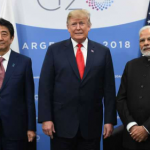This speech was given by Ambassador Rajiv Bhatia, Distinguished Fellow, Foreign Policy Studies, Gateway House, at a roundtable discussion on ‘India and Strategic Autonomy’ organised by the Centre for Joint Warfare Studies (CENJOWS). Click here to view details of the event.
Introduction
- Global politics has gone through three main phases since WWII:
- 1945-89: Bipolarity
- 1989-2008: Unipolarity
- 2008-2019: Multipolarity
- India’s manner of relating to the world contains both constant and new features, ranging from the Non-Alignment (NA) to Strategic Autonomy (SA).
- A quick reading of the reference to SA in PM Modi’s Shangri-La address should be instructive:
Beyond East and Southeast Asia, our partnerships are strong and growing. It is a measure of our strategic autonomy that India’s Strategic Partnership, with Russia, has matured to be special and privileged.
Ten days ago, in an informal summit at Sochi, President Putin and I shared our views on the need for a strong multi-polar world order for dealing with the challenges of our times. At the same time, India’s global strategic partnership with the United States has overcome the hesitations of history and continues to deepen across the extraordinary breadth of our relationship. It has assumed new significance in the changing world. And, an important pillar of this partnership is our shared vision of an open, stable, secure and prosperous Indo-Pacific Region. No other relationship of India has as many layers as our relations with China. We are the world’s two most populous countries and among the fastest growing major economies. Our cooperation is expanding. Trade is growing. And, we have displayed maturity and wisdom in managing issues and ensuring a peaceful border.
Specific Responses to Queries by CENJOWS
- Disagree: NA and SA are not synonymous:
- Agree: SA defines the Indian foreign policy today. It is a valid policy response/strategy in the world stamped by VUCA (Volatility, Uncertainty, Complexity and Ambiguity).
- In appearance, the two are different – the one non-alignment, the other multi-alignments; the one in the bipolar world, the other in the multipolar world; the one where India acted as a key leader of the South, the other where India is a leader among select powers (both of the Global South and among today’s major power centers).
- In essence, the two are similar in the sense that both assume India would judge issues and relations on merit, not on the dictates of other powers. SA is all about issue-based alliances.
- In the international environment i.e. actual operational conditions, the change is striking.
- There were three phases in the evolution of NA: 50s – India’s high moral and political standing (Bandung); 60s – post-1962 syndrome; 70s – when our NA had a clear pro-Soviet Union tilt.
- Now too: our SA seems to change colour frequently, depending on turns and twists of global politics.
- Both concepts involve Resilience, Dynamism, Pragmatism, and they both avoid static stances. Both are susceptible to the unspoken accusation that India is not a reliable partner!
- India in Indo-Pacific: No, it is not a lone balancer; it is part of a strategy to counter China. In the future, the Quad will become effective in proportion to China’s aggressive behaviour.
- India in the Indian Ocean: No, India is not a balancer. It is a contender as a major resident power to curb China’s influence. It will succeed only with the help of others – US, France, UK, key IORA players etc.
- New Cold war between US, and Russia/China: Too early to determine its contours and impact, especially due to the uncertainty about the wildly fluctuating US-China relationship. Will the current trade disputes end up in a deal or greater confrontation? Trump is a wild card! And the US begins the election season.
- No, of course we cannot develop without external support. We need technology, capital, markets, skills, defence equipment, international networking, and global cooperation to resolve global issues. Hence, SA with pro-active international engagement with all continents should be our goal.
- Partnerships, not alliances, represent the way out. We can have them with all major power centers. Our Chairmanship of G20 in 2022 and advance preparations involve a huge responsibility.
- However, internally we need a mechanism (both in the government and at Track II level) that guides the nation to manage the complex web of India’s partnerships.
Rajiv Bhatia is Distinguished Fellow, Foreign Policy Studies, Gateway House
This speech was delivered at a roundtable discussion on ‘India and Strategic Autonomy’ organised by the Centre for Joint Warfare Studies (CENJOWS) in New Delhi, on 7 February, 2019. Click here to view details of the event.
For interview requests with the author, or for permission to republish, please contact outreach@gatewayhouse.in.
© Copyright 2019 Gateway House: Indian Council on Global Relations. All rights reserved. Any unauthorized copying or reproduction is strictly prohibited


